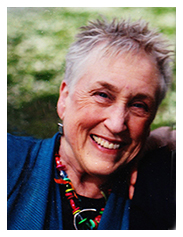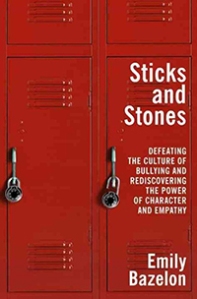Vicky Kelman
 Sticks and Stones: Defeating the Culture of Bullying and Rediscovering the Power of Character and Empathy by Emily Bazelon
Sticks and Stones: Defeating the Culture of Bullying and Rediscovering the Power of Character and Empathy by Emily Bazelon
There is probably no word that grabs the attention of parents and educators as immediately, or strikes fear into their hearts as completely as “bullying.”
Before we get into it…A phrase of Emily Bazelon’s which I suggest keeping in mind when confronting bullying ( in real life or in a book) is “maddeningly complex, “. And it is.
 Sticks and Stones is a fascinating book. Everyone who lives with kids or works with kids should be reading it. Not because what to do when bullying occurs will be so clear to you after having read it, but because you will enter into a fraught situation knowing it to be “maddeningly complex” from the get-go.
Sticks and Stones is a fascinating book. Everyone who lives with kids or works with kids should be reading it. Not because what to do when bullying occurs will be so clear to you after having read it, but because you will enter into a fraught situation knowing it to be “maddeningly complex” from the get-go.
It’s clear that one of the dangers in dealing with bullying is that the word itself tends to be used very loosely. Not all “bullying” is bullying. Sometimes it’s a case of a mean kid. Sometimes it’s a case of ” teenage drama.” But, use the “b” word and everything intensifies.
According to Bazelon, Bullying has three primary characteristics (developed by Dan Olweus, a Swedish academic who was the first to do serious research on the phenomenon of bullying, starting in the early 1970s) : 1) verbal or physical aggression, 2) repeated over time and 3) involving a power differential between bully and victim.
The core of the book consists of three “case studies” (stories) of bullying. All actually occurred fairly recently, and might be familiar to you. One received extensive newspaper coverage at the time and one is included in a widely seen documentary.
All the elements and complexities that surface in these cases are analyzed as Bazelon unpacks these cases for us. Not one of these cases is “solved” in a way you might imagine or wish to see, though most of the kids (victims and bullies) seem, eventually, to find a way to put their lives back together.
The variables in every bullying situation are beyond counting and the bully-victim combinations probably reach infinity. (Bazelon identifies five types of bullies ; victim profiles seem even more varied. ) Bullies and victims enter into these situations with a range of personal “baggage,” family situations, weakness and strengths, community culture and school culture that make it impossible to construct one approach. Maddeningly complex!
And cyber-bullying? Where does that fit in? Has it made for more bullying? Probably not — but it has made bullying more pervasive and has given bullies more power. Bazelon points out that whereas bullying has always been part of school life, kids were able to leave school and find some shelter from the bully at home or in outside activities. Now, thanks to the internet and social media, bullying can follow kids everywhere they go. There is no shelter. Mean words said between two kids at lunchtime can reach 100 more kids before the day is over. And like the old parable of the feather pillow, the words can’t be collected and taken back. The internet “makes bullying more lasting, more visible, more viral.” (Introduction)
The post-colon title of this book is “defeating the culture of bullying and rediscovering the power of character and empathy.” I did not find a clear path to defeating the culture of bullying (it’s maddenly complex) but the book did direct me toward educating for character and empathy as paths to prevent, curtail or restrain bullying. It’s clear that family, school and community need to join together in joint effort to create a social climate that supports kids as they learn to be empathetic, “learning how to help themselves and each other through rough patches” (Introduction) “Some studies have shown that most kids who are bystanders don’t like bullying and would step in if they only knew how. And they have an impact: when bystanders do stand up for victims, they stop bullies in their tracks as often as half the time.” (ch 4)
As I read this book , (which is a gripping read) one phrase kept popping into my head: HaShomer Ahi Anokhi? Am I my brother’s ( my fellow human’s) keeper? Surely, one of the first things I learned in my Jewish education and something I have had the chance to teach many times is that the answer to that question is always YES. Bullying may be less “exotic” and dramatic than freeing Soviet Jewry or fighting for Civil Rights, gun safety or food justice…but that YES seems to apply as strongly. How do we develop schools with a climate that supports all kids (victim and bully), teaches modes of interpersonal problem solving, guides parents to get involved when there is bullying (and not only when their own child is a victim) and teaches kids to stand up for themselves AND to step in when they see one student mistreating another? “If it’s mean – intervene.” ( ch 7 ) We all need to become our brothers’, sisters’, kids’ and neighbors kids’ “keepers. (Note: the Hebrew word shomer is closer in meaning to the “guardian” than to keeper).
Bazelon makes a strong case for why schools must lead the anti-bullying enterprise, but it is also clear that parents have to shoulder some of the burden both in what they expect from their schools, how they pay attention to character development of their own children and the kind of role-modeling they themselves provide.
Anti-bullying seems to be an umbrella term which includes general approaches to enhancing a school’s social and emotional climate. Bazelon reviews some of the commercially “packaged” training programs for teachers and students that have been adopted around the country. As you would suspect, they vary in quality, cost and effectiveness. Success depends on the degree of buy-in brought to the problem by school leadership. ”A school has to commit to changing …and then get traction not just with staff and students but with their families and the larger community.” (ch. 3) Using anti-bullying tools to create a safe, calm, respectful environment is a major undertaking requiring leadership and strong partnerships.
Do you know what your kids’ schools (or your neighborhood schools) have in place in terms of anti-bullying policies? Are there guidelines for everyday personal interaction and consequences and support when there is a problem? Are there guidelines for being a good “digital citizen” in school and at home? What are the policies in place in your synagogue’s school, your local Jewish day school, youth group or summer camp? If you don’t know — get curious! Think about anti-bullying policies as a kind of earthquake preparedness (or fill-in your local non-California situation) and be ready. If you need it – you have it handy — and if you never have to use it – great!
At the end of Sticks and Stones, a bonus awaits the reader: The sections entitled Frequently Asked Questions About Bullying and Resources for Readers alone are worth the price of the book — but much more meaningful in context of the whole book.
As I write, the holiday of Purim is just a few weeks away. In the Purim story, Haman, the villain, is understood to be descended from Amalek the prototypical villain of the Exodus story in the Torah. We are told: Zachor et Amalek ; remember Amalek who attacked the children of Israel in the desert on their way to the land of Canaan.
Amalek attacked the end of the long line of Israelites wending their way through the desert.. And who was at the back of that long line? The women, the children, the old and the infirm…the most vulnerable among the people. . Amalek was a bully, no doubt. However, often lost in the telling is the important fact that the Israelites had left their most vulnerable exposed and unprotected at the end of the line. If I understand Bazelon correctly, the kids who bully and the kids who are their victims are among our most vulnerable. Let’s not repeat that mistake!
Post-script: And if you think middle school is soon enough to deal with these issues — think again. For a look at how these issues play out with younger kids (starting with pre-school), read You Can’t Say You Can’t Play by Vivian Gussin Paley

